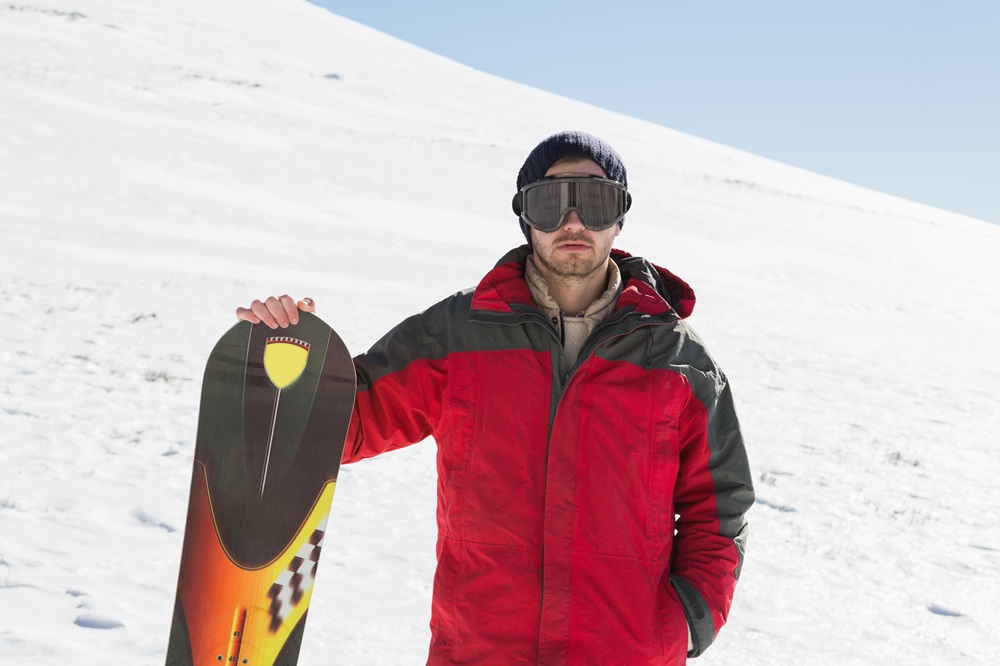When shopping for mens snowboarding jackets, understanding breathability ratings can feel like decoding a secret language.
But here’s the thing – getting this right can make the difference between an epic day on the slopes and a uncomfortable, sweaty mess. Let’s dive into the science of staying dry while shredding powder.
The Science of Sweat Management
Did you know? The average person produces between 0.8 to 1.4 liters of sweat per hour during intense physical activity.
When snowboarding, your body’s cooling system kicks into high gear, especially during those heart-pumping runs and challenging terrain.
The magic happens in the interaction between your body heat, sweat production, and your jacket’s ability to let that moisture escape.
Think of your jacket as a one-way door – it needs to keep snow out while letting sweat vapor escape.
Understanding Breathability Ratings
Here’s a breakdown of common breathability ratings and what they actually mean:
| Rating (g/m²/24hrs) | Activity Level | Riding Style |
| 5,000-10,000 | Light | Casual resort riding, beginner slopes |
| 10,000-15,000 | Moderate | All-mountain riding, occasional backcountry |
| 15,000-20,000 | High | Aggressive riding, frequent backcountry |
| 20,000+ | Very High | Splitboarding, intense backcountry expeditions |
Key insight: These numbers represent how many grams of water vapor can pass through one square meter of fabric in 24 hours. The higher the number, the better your jacket can handle intense activity.
Matching Intensity to Breathability
Let’s break down how to match your riding style with the right breathability rating:
Resort Riding (5,000-10,000 g/m²/24hrs)
If you’re spending most of your time cruising groomers and taking regular breaks, a lower breathability rating will suffice. You’re likely generating less heat and sweat, so you don’t need the most technical gear.
All-Mountain Performance (10,000-15,000 g/m²/24hrs)
This is the sweet spot for most riders. You’re mixing up your terrain, working hard on some runs, and taking it easy on others. These jackets offer excellent versatility for varying intensity levels.
Backcountry Missions (15,000+ g/m²/24hrs)
Research shows that backcountry riders can burn up to 600 calories per hour – that’s a lot of heat and sweat to manage. You’ll want maximum breathability here to handle steep climbs and intense riding.
The Role of Temperature
Your jacket’s breathability becomes even more crucial as temperatures rise. Here’s why:
| Temperature Range | Sweat Production | Recommended Breathability |
| Below 20°F (-6°C) | Lower | 5,000-10,000 g/m²/24hrs |
| 20-32°F (-6 to 0°C) | Moderate | 10,000-15,000 g/m²/24hrs |
| Above 32°F (0°C) | Higher | 15,000+ g/m²/24hrs |
Remember: Warmer temperatures mean more sweat, requiring better moisture management.
Layering Strategy Matters
Your jacket’s breathability works in tandem with your base and mid layers. A common mistake is focusing solely on the jacket while ignoring the rest of your setup.
Consider this layering approach:
- Base Layer: Moisture-wicking material (merino wool or synthetic)
- Mid Layer: Lightweight insulation that complements your jacket’s breathability
- Outer Layer: Your carefully selected jacket with appropriate breathability rating
Real-World Performance Factors
Several factors can affect how well your jacket’s breathability performs:
Humidity Impact
Scientific studies indicate that high humidity can reduce breathability effectiveness by up to 30%. In humid conditions, consider upgrading to a higher breathability rating than you might normally choose.
Elevation Considerations
For every 1,000 feet of elevation gain, your body typically works 10% harder. This means more sweat production at higher altitudes, requiring better breathability.
Maintenance for Maximum Performance
To maintain optimal breathability:
| Maintenance Task | Frequency | Impact on Breathability |
| Wash with technical cleaner | Every 10-12 uses | Restores 90-95% of original performance |
| Reapply DWR coating | Every 15-20 washes | Maintains water repellency |
| Air dry after use | Every use | Prevents moisture buildup |
Pro tip: A clean jacket performs significantly better than a dirty one when it comes to breathability.

When to Upgrade Your Jacket
Consider upgrading when:
- You’re consistently feeling overheated during rides
- Your current jacket shows signs of reduced performance
- Your riding style has evolved to more intense activities
Technology Innovations
Recent advances in fabric technology have introduced some game-changing features:
Active Ventilation Systems
New research shows that strategic vent placement can increase overall breathability by up to 40%. Many modern jackets incorporate this knowledge into their design.
Smart Fabric Development
The latest materials can adapt their breathability based on your body temperature, providing optimal performance across varying conditions.
Making the Final Decision
When selecting your jacket’s breathability rating, ask yourself:
- What’s my typical riding intensity?
- Where do I spend most of my time riding?
- How much do I typically sweat during activity?
Remember: It’s better to have slightly more breathability than you need rather than not enough. The extra cost often pays for itself in comfort and performance.
Investment Considerations
High-breathability jackets typically cost more, but consider this value proposition:
| Breathability Rating | Average Price Range | Cost per Season* |
| 5,000-10,000 | $100-200 | $33-67 |
| 10,000-15,000 | $200-300 | $67-100 |
| 15,000-20,000 | $300-400 | $100-133 |
| 20,000+ | $400+ | $133+ |
*Based on a three-season lifespan with proper care
Conclusion
Choosing the right breathability rating isn’t just about comfort – it’s about maximizing your time on the mountain.
By matching your jacket’s capabilities to your riding style, you’re setting yourself up for better performances and more enjoyable sessions.


